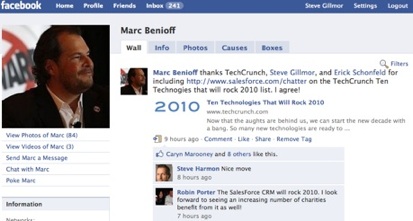 Marc Benioff commented on Facebook about Erick Schonfeld’s list of important technologies of the coming year, pleased that Erick thought Salesforce Chatter was going to be a big deal. I agree: Chatter is likely to become a key differentiator in the contest for momentum in cloud computing. Up until now, Twitter and Facebook have had the game all to themselves, with Google content to experiment with Wave and Microsoft busy launching Azure.
Marc Benioff commented on Facebook about Erick Schonfeld’s list of important technologies of the coming year, pleased that Erick thought Salesforce Chatter was going to be a big deal. I agree: Chatter is likely to become a key differentiator in the contest for momentum in cloud computing. Up until now, Twitter and Facebook have had the game all to themselves, with Google content to experiment with Wave and Microsoft busy launching Azure.
Chatter will inevitably go right at the heart of Microsoft’s Sharepoint strategy, which has some serious legs now that the company has wired Visual Studio up to it on the development front and Silverlight on the display side. With Windows Mobile 2010 and Silverlight Mobile still officially unannounced, Chatter has an interesting opportunity for the next three months or so to slipstream alongside Nexus One and Android. This gives Benioff plenty of red meat on the marketing front, but behind the scenes the real target is Twitter.
Chatter was pitched as a Facebook clone, and the more Facebook tweaks their status model the more it begins to look like FriendFeed on steroids. By tagging me in his Erick status update, I received not only Marc’s message but the replies of others in an email thread which pointed me back to a FriendFeedy conversation thread. So far Twitter has resisted harnessing its reply_id capability for conversations, leaving the field wide open for third party clients to (so far) pick up the ball. Robert Scoble was promoting one FriendFeed killer the other day that might go there with a promised UI overhaul, but my bet is on Facebook morphing quicker.
So now we get Facebook and Facebook Connect operating as a stalking horse for establishing an identity map that Chatter can do a LinkedIn party on. For each civilian identity, Chatter offers an extended professional identity with tools to cross-index among enterprises and their internal taxonomies. It’s like taking Twitter lists and harnessing them across affinity groups inside and across companies, leaving Twitter and its clients to carving up the customer end of the transactions. But guess where the carrots lie for those customers? The MinorityReport location-aware enterprises that have realtime deals just waiting to be pitched to those who register for stream offers.
CRM is the logical clearing house for these relationships, as long as care is taken to establish trust and authenticity at the intersection of public and private networks. I’ve often felt Facebook makes too much of the difficulty of transitioning its cloud to the apparently more open Twitter stream. With Chatter, that responsibility shifts to the Facebook Connect channel and the credibility of businesses seeking to engage with the social marketplace.
We’ve already seen the impact of service industries such as food and live entertainment (Yelp, FourSquare, etc.) Next may well be the media companies, once the tools of the trade ship over the next few months. Chatter’s application updates are a huge opportunity for the record companies to stave off a further collapse; same goes for the products formerly known as magazines. Just because the mainstream media is glomming onto Twitter as a realtime DVR index doesn’t mean private streams can’t be nailed up and distributed interactively by newmedia publishers with much higher signal to noise and the yield that comes from mining authority.
Salesforce has consistently outperformed the expectations of its competitors, not so much by some magical formula as by understanding the principles of bootstrapping pioneered by an early group of engineers and standards politcos. Google’s success at decoupling Office from our private lives has now rendered the opportunity to remake the business relationships from the inside out. Chatter can instantiate customer relationships based on what gestures we send to signal streams of our willingness to sip and save.
Chatter is not without challenges; figuring out the intersection of Twitter and Facebook will not come easily. But if Benioff continues to do what he has been doing now for the ten years of the Web Services revolution — correctly marrying a strong sense of what technologies will stick and foster consumer acceptance with the opportunities to disrupt slow moving competitors from his past — he and his company will continue to prosper.